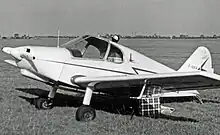CAB Minicab
The CAB GY-20 Minicab is a two-seat light aircraft designed by Yves Gardan and built in France by Construction Aeronautiques du Bearn (CAB)[2] in the years immediately following World War II. CAB was formed in 1948 by Yves Gardan, Max Lapoerte and M. Dubouts.[3]
| GY-20 Minicab | |
|---|---|
 | |
| GY-201 Amateur-built in the UK | |
| Role | light aircraft |
| Manufacturer | Constructions Aéronautiques du Béarn |
| Designer | Yves Gardan |
| First flight | 1 February 1949 |
| Number built | 65[1] + ca. 130 homebuilt |
| Variants | GY-30 Supercab |
Design and development
The Minicab is a conventional, low-wing cantilever monoplane with fixed tailwheel undercarriage, powered by a Continental A65 engine. Its design was a scaled-down version of the aircraft that Yves Gardan had designed for SIPA, the SIPA S.90. The pilot and passenger sit side by side and access to the cockpit is via a one-piece perspex canopy that hinges forwards. Gardan's intention was to produce a low-cost, easy-to-fly, easy-to-maintain aircraft with the possibility of homebuilding.[4]
Production
The prototype Minicab first flew at Pau-Idron on 1 February 1949 with Max Fischl at the controls. CAB manufactured a total of about 65 Minicabs when production ended in 1955.[1][5] The rights for the plans were then acquired by Arthur Ord-Hume in the United Kingdom who anglicised the drawings and made various minor improvements for home-builders.[2] A large number were completed by amateur builders in the United Kingdom, France and other countries around the world.[4] There is about 20 Minicabs currently active in the United Kingdom, many of which were built (or rebuilt) to the JB.01 standard, developed by M. Jean Barritault, usually with a Continental C90 engine.
Falconar sold plans for a tricycle gear homebuilt model named the Minihawk.[6] Another development is the K&S or Squarecraft Cavalier which is a redesigned Minicab in several versions with plans translated from French to English and modified by Stan Mcleod. The plans were marketed by K&S Aircraft of Calgary, Alberta and later MacFam.[7]
Operational history

Type certification was obtained in mid-April 1949. By the end of 1950, a Minicab had won the Coupe de Vitesse de Deauville (Deauville Cup for speed), and the Grand Prix Aérien de Vichy (Vichy Aerial Prize).[1] The following year, a Minicab broke the world air distance record for its class (1,825 km, 1,138 miles) and in 1952 it attained the world airspeed record for its class over a 2,000 km circuit, with an average speed of (183 km/h, 114 mph).
One Minicab, G-AWEP, was flown by the ex-RAF fighter pilot Roland Beamont who was a test pilot at BAC Samlesbury. He made its first flight in 1969 and wrote that "the Minicab felt light and very responsive... landing required the delicate touch of a Spitfire pilot. In fact the overall control harmony is not dissimilar to that classic aeroplane".[8]
Variants
- GY-20 Minicab
- CAB first production model.[4]
- GY-201 Minicab
- refined version with increased fuel capacity, reduced wingspan, strengthened undercarriage, split flaps, and castoring tailwheel.[5] CAB final production model and also principal homebuilt version.[4]
- Barritault JB.01 Minicab
- built to the modified design of Jean Barritault.
- Falconar Hawk
- Minicabs built to plans supplied by Falconar
- Falconar MiniHawk
- plans-built design from Falconar with tricycle undercarriage.
- MacFam Cavalier (K&S or Squarecraft Cavalier)
- Redesigned in several versions principally with tricycle and swept tail surfaces, and strengthened for a more powerful engine.[7]
Specifications (GY-20)
Data from Jane's All The World's Aircraft 1956–57[9]
General characteristics
- Crew: one
- Capacity: one passenger
- Length: 5.45 m (17 ft 11 in)
- Wingspan: 8.14 m (26 ft 8 in)
- Height: 1.65 m (5 ft 5 in)
- Wing area: 10.15 m2 (109.3 sq ft)
- Empty weight: 270 kg (595 lb)
- Gross weight: 485 kg (1,069 lb)
- Fuel capacity: 50 L (11 imp gal; 13 US gal)
- Powerplant: 1 × Continental A65 four-cylinder air-cooled horizontally-opposed piston engine, 48 kW (65 hp)
- Propellers: 2-bladed Merville wooden, 1.64 m (5 ft 5 in) diameter
Performance
- Maximum speed: 180 km/h (110 mph, 97 kn)
- Cruise speed: 170 km/h (110 mph, 92 kn)
- Service ceiling: 4,000 m (13,000 ft)
- Rate of climb: 3.0 m/s (590 ft/min)
- Take-off run to 20 m (66 ft): 370 m (1,210 ft)
- Landing run from 20 m (66 ft): 343 m (1,125 ft)
References
- Notes
- Canal Blog "Le Minicab"
- Jackson Vol II, 1988, p.377
- Bruno Parmentier (2000-06-17). "C.A.B. GY-20 'Minicab' - Tourisme - Un siècle d'aviation française". Aviafrance.com. Retrieved 2022-08-31.
- Ord-Hume, 2013, pp.204-205
- Oldtimer-Homepage der Segel- und Motorfluggruppe Veterano, Birrfeld
- "Falconar Plans". Retrieved 2 September 2013.
- Jackson Vol III, 1988, p.442
- Beamont, 1980, p.153
- Bridgman 1956, pp. 132–133.
- Bibliography
- Bridgman, Leonard (1956). Jane's All The World's Aircraft 1956–57. New York: The McGraw-Hill Book Company.
- Beamont, Roland (1980). Testing Years. London: Ian Allan. ISBN 0-7110-1072-2.
- Jackson, A. J. (1988). British Civil Aircraft 1919–1972: Volume II. London: Putnam. ISBN 0-85177-813-5.
- Jackson, A. J. (1988). British Civil Aircraft 1919–1972: Volume III. London: Putnam. ISBN 0-85177-818-6.
- Ord-Hume, Arthur W. J. G. (2013). British Private Aircraft 1946–1970: Volume 2. Petersfield: MMP Books. ISBN 978-83-61421-92-4.
- Simpson, R. W. (1995). Airlife's General Aviation. Shrewsbury: Airlife Publishing. p. 409.
- Taylor, Michael J. H. (1989). Jane's Encyclopedia of Aviation. London: Studio Editions. p. 123.
- AviaFrance CAB GY-20 Minicab
- Canal Blog "Le Minicab"
- Oldtimer-Homepage der Segel- und Motorfluggruppe Veterano, Birrfeld
- Musée Régional de l'Air d'Angers-Marcé
- The Rochester GYAT Flying Group